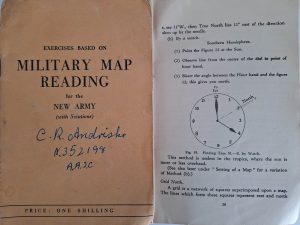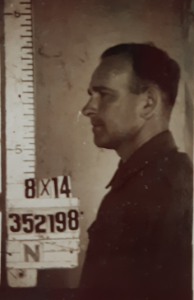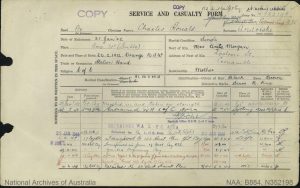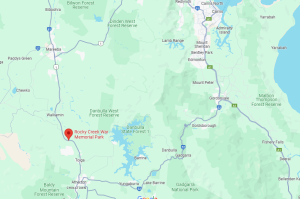My paternal grandfather, Charles Ronald (Charlie) Andriske, spent three years in the Army Service Corp during WW2. Raised in the small western New South Wales town of Coonamble, it was a place Charlie’s family had lived in since 1903. The Andriske family were of Prussian (German) and English heritage. Soon after arrival in the town, the patriarch, Carl Andriske, died of typhoid fever in an outbreak that would devastate the small community. Leaving behind his wife Emma and their seven children, the family remained in the town that supported them in their time of grief and hardship. It was a bond never forgotten, despite the anti-German sentiment that would be brought forth by WW1 and WW2. Unlike many other families across Australia though, the Andriskes never felt the need to anglicize their surname to something less German sounding.
Charlie’s mother, Unita, was seven when the family arrived in Coonamble. She would soon integrate and become friends with many of the local children whose families had lived in Coonamble for many generations. At age 16, Unita was sent away from home to Orange, where she either entered a mother and baby home or lived with someone she knew, and there she gave birth to Charlie. In a time when unmarried mothers were scorned, Unita was supported at home by her mother and allowed to keep her baby son. Charlie was 2 years old when WW1 broke out and seven when it ended, so whilst his memories of the time may have been faint, he most certainly grew up hearing stories of the treatment of German born citizens during the war. Australia’s government had declared citizens with German backgrounds potential enemies and some 4,500 people were interned in camps. With anti-German sentiment high and those with German sounding names treated with suspicion, a small community like Coonamble may have afforded the Andriske family some protection. It was with this backdrop to his life that Charlie Andriske enlisted to defend his country from foreign invasion.
Charlie grew up with cousins from both his mother’s and father’s side. Although kept a secret of sorts, Charlie was aware that his biological father was a man named Fred Lees, whose family had been in the Coonamble area for generations. DNA has recently confirmed the Lees connection. Charlie left school in 1927 aged 15. He would spend the next 14 years in the sheep industry, in company with drovers and shearers, working as a baker and station hand. With conflicts already happening in Europe, the price of wool, needed for soldier’s uniforms, continued to increase. The Coonamble district benefited from this boom, and Charlie had steady work. Then in September 1939, Germany invaded Poland and Britain entered the war, with Australia following suit.
For Charlie nothing changed initially. He continued working in his isolated community and like many others, probably thought the war was a world away in Europe. However, tensions in the Pacific were rising. With recruitment for the war effort slow, in November 1941 a contest was begun across NSW, to award a monthly victory flag to the district whose enlistment figures were the highest per proportion of population. That month the very first victory flag was awarded to Coonamble. They had narrowly beat Peak Hill and Gerringong for the honorary prize. Coonamble’s enlistment totals were; Men overseas, 153; in camp, 48; killed in action, 3; prisoners of war, 3 and returned wounded, 6. That meant a total of 213 men from a population of 3,150 with more to come in the following months and years. A few days later, the whole town celebrated the win and added the 25 pound cheque to the local patriotic fund, which had already raised some 3000 pounds.
Within a week of the awarding of the Victory flag, the newspapers were full of the news that the Japanese had attacked Pearl Harbour, a naval base in Hawaii. In the month that followed, some sixty men from Dubbo (the nearest large town) enlisted in the AIF as the seriousness of the threat to Australia grew. Universal training from late 1941, for men aged 19 to 35, was introduced to bolster the Citizen Military Force (CMF), a volunteer army who were not expected to fight overseas, but rather protect Australian shores. In January 1942, Charlie Andriske enlisted in the CMF, joining many of his mates from Coonamble, including his future brother-in-law Jim Conn. He was allocated to 17 Company of the Australian Army Service Corp. This corp was responsible for the movement and supply of consumables such as food, petrol and ordnance and for troop transportation. Both Charlie and Jim would work as drivers.

Charlie, army number N352198, was assigned to the 2nd Division Petrol company and travelled to Wallgrove, in Sydney, where he would remain for the next few months, in training. A typical day would begin with Reveille at 6am, parade at 6.30am, breakfast at 7.45am, followed by lessons or training, then a midday meal at 12.45pm. With more lessons or training in the afternoon, the troops would be dismissed at 4.30pm, have dinner at 5.15pm, with free time until lights out at 10.15pm. Charlie’s petrol company had approximately 420 recruits. Throughout February 1942, the recruits trained in map reading, rifle exercises, camouflage and concealment, gas drills, driver training, vehicle maintenance and more. There is no doubt that Charlie and his mates were listening carefully to the instruction given, particularly as word came through of the fall of Rabaul, Ambon and Singapore, all captured by the Japanese in late January and early February 1942. And then came the Japanese bombing of Darwin, an assault on Australia that fueled the fire in the recruits. Over 250 people, including civilians were killed in the Darwin bombings and a further attack on Broome, in northwest Western Australia would kill over 80 more people. Sydney also came under attack by Japanese submarines, who entered Sydney Harbour on 31 May 1942, whilst Charlie was still in training in the city. The attacks on mainland Australia forced a restructure of the army with divisions created for the defence of each state. In July 1942, Charlie was allocated to the Western Australia Line of Communication area, where he would spend the next eighteen months in defence of the home front. Some of Charlie’s training material, two booklets about Military Map Reading, have survived and these give a glimpse into the kind of mathematical and logistical comprehension required.

More information on Charlie’s time training in the 2nd Petrol Company in Sydney can be found in the unit diaries; AWM52 10/25/2/1 – [Unit War Diaries, 1939-45 War] 2 Division Petrol Company, February 1942 | Australian War Memorial
On the 22nd of July 1942, Charlie and Jim, along with 280 other troops, were moved out of Wallgrove Camp to Rooty Hill where they boarded a train bound for Melville Camp near Fremantle, Western Australia. The eight box carriage train journey took them through Junee and Albury (NSW), Melbourne (VIC), Tailem Bend, Goodwood and Port Pirie (SA), Kalgoorlie, Meridin and finally South Beach, Fremantle (WA). The journey took four and a half days. Upon arrival the troops marched 3 miles to Melville Camp. At this point the petrol company was renamed 17 Company Australian Army Service Corp, 5 Infantry Brigade, 2 Australian Division, led by Major F.L. Harvey. The Army Service Corp was responsible for the transport and provision of supplies and rations other than machinery or ammunition. They also delivered mail and provided transport resources for the troops.

At the end of August 1942, the company moved to No.9 Camp Bushmead, in Perth. The company would move around over the next year and a half, to Gingin, Strawberry, Bringo and Nanson Military Camps. On the 15 December 1942, whilst stationed at Strawberry Camp, south of Geraldton, Charlie’s unit, the 17 Company A.A.S.C was threatened by a bushfire. The fire broke out at about 12pm in a heavily timbered area north of the camp. With quick action taken however, the fire was put out in two hours and disaster averted. By 6 April 1943, Charlie was in Bringo, about 30kms east of Geraldton. The John Curtin led government had just passed an act that required the Citizen Military Forces to fight outside of Australia, in the South-Western Pacific theatres of war, including New Guinea, Borneo and Java. Charlie, 30 years old and a strapping 5ft 8 inches tall, passed his medical and was classified as A1. This was defined as medically fit for service in any locality. It meant that Charlie’s home front experience could turn, at any time, into active overseas service. The troops kept themselves busy in their free time with physical games, including on Christmas Day 1943 whilst in Nanson Camp north of Geraldton, when they held a sports day.
More information about Charlie’s day to day life in 17 Company can be found in the unit diaries here: AWM52 10/17/17/1 – [Unit War Diaries, 1939-45 War] 17 Company AASC [Australian Army Service Corps] July 1942 | Australian War Memorial

Meanwhile Jim Conn had been promoted to Acting Corporal in November 1942. He would later lose this, due to disciplinary action and returned to the level of Private. The two would forge a great friendship and serve together throughout their three years of service.
In late January 1944, Charlie, Jim and about a hundred others were taken by train from Geraldton to be transferred to the QLD Line of Communication. They were sent to the Atherton Tablelands. It was during this time that Charlie recorded his only blemish on an otherwise perfect service record. For what was termed ‘neglect of good order and discipline’, Charlie was fined 10 shillings. His transfer to QLD was completed in April 1944 with his assignment to the 132 Australian General Transport Company. This unit had been the first to arrive on the Atherton Tablelands, in Far North QLD. The location of Rocky Creek, between Mareeba and Atherton, was selected for its proximity to Cairns, a major seaport, and to New Guinea. Bearing a similar climate to New Guinea, but without the added risk of malaria, it was the perfect base to build a military camp and repatriation hospital. Other facilities included an open-air picture theatre, a recreation room and a tennis court for the 3,000 personnel stationed there. In June 1944, Charlie was assigned to 26 Australian Maintenance Platoon which comprised of around 50 personnel from carpenters, bricklayers, plumbers, electricians, storemen, mechanics and drivers who worked on the maintenance of the camps. In December 1944, Charlie developed dermatitis venenata, an inflammatory skin irritation, caused by plants and/or chemicals. He spent a week at the 2/2nd Australian Casualty Clearing Station being treated before returning to his unit. It was the only medical ailment recorded during his army service.
Meanwhile Australian troops were still fighting the Japanese in New Guinea whilst Charlie was in QLD throughout 1944 and 1945. Charlie was lucky to have never been called upon to service overseas. The Japanese surrendered after the U.S dropped atomic bombs on Hiroshima and Nagasaki and the peace deal was signed on 2 September 1945. Charlie’s three years of service was about to come to an end. Today the Rocky Creek site is a memorial park that can be visited. A plaque denotes the service of the ‘Roadburners’, the first transport company to arrive on the Atherton Tablelands.

Gradually troops were released from their duties. Charlie would return to Sydney and be given a leave pass until the 22nd of November 1945 when he was to present at the Leave and Transit Depot in Addison Road, Marrickville for the pre-discharge procedures. Two army slips show the items he was required to hand in, which included; Belt & Braces, Scabbard, Bottle, Frog Bay Pack, Sling Rifle, Ground Sheet, Stretcher, Bayonet and Steel Helmet. Charlie was finally de-mobilised on 3rd December 1945 with a payout figure of 134 pounds. De-mobilised personnel were given a booklet called ‘Return to Civil Life’ which Charlie kept. The fifty-page booklet outlined their entitlements and employment opportunities and offices were set up to help soldiers find employment or return to their previous employer, for which they had priority over others. Charlie returned home to Coonamble in December 1945, his mother surely grateful to have her son home for Christmas, and for good.
A few months after leaving the army, Charlie would receive a letter in the mail detailing his entitlement to a war gratuity. This payment was calculated on service from December 1941, after Japan had entered the war. With 44 months (3 years and 8 months) of qualifying service, Charlie’s gratuity was 33 pounds, to be paid on the 3rd March 1951. With his marriage to Connie and the arrival of their twins in March 1950, no doubt the gratuity helped them buy the house in Mendooran Street, Coonamble. Charlie would remain in this house, his pride and joy despite its rundown appearance, for the next forty years.
Charlie’s days of adventure were now over and he settled back into the life he had known prior to the war, albeit eventually with a wife and five children. During the 1980s, when I would travel a couple of hours with my family to see him and my grandmother, he would always ask me the same question. ‘How’s dirty old Dubbo?’ I’d retort back, ‘How’s dirty old Coonamble?’ He remained loyal to his hometown and would never have considered moving elsewhere. I never quite understood why until now. Whilst my grandmother Connie was an open book and we had many conversations about her past, I never once asked Pop about his past. I wonder if he would have told me about his war experiences if I had thought to ask. When asked by other family members, he said his time in the army was the ‘worst three years of my life’. Coonamble was home, it was familiar and it was small enough that you knew everyone. It was the place he surely felt safe, far removed from what he saw as the dangers of the cities. Living through those war years and understanding how close Australia came to invasion left a lasting impression on Charlie. On Anzac Day, let us then remember those who sacrificed so much in their defence of Australia’s home front.
Charlie’s service record can be viewed at the National Archives of Australia website; www.naa.gov.au
